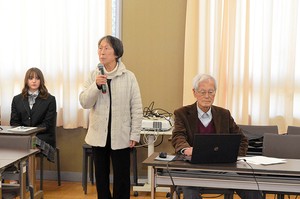By SHINYA MURASE/ Staff Writer
September 27, 2023 at 06:30 JST
Shogi professional Madoka Kitao recently ended her playing career but the contribution she made to the traditional board game will be felt for generations to come.
Kitao, 43, devised “Dobutsu Shogi” (animal shogi), aka “Let’s Catch the Lion,” which has helped expand the shogi fan base worldwide, introducing an easier-to-play game for beginners that also appeals to children.
The simplified version is played with a set of pieces that include a lion and a giraffe.
FINAL MATCH IN JULY
Kitao, a shogi player with the title of 2-dan in the women-only ranking system, retired after playing professional for 23 years.
She has worked equally hard on public promotional activities, both in Japan and abroad, on the sidelines of her professional competition.
In her last match on July 10, Kitao bowed to her opponent ahead of the start at 10 a.m. in a game room on the fourth floor of Shogi Kaikan hall in Tokyo’s Shibuya Ward.
“Let’s have a good game,” she said and made the first move with P-76.
Kitao was playing her eighth, and final, game in class D of the Joryu Juni-sen, the preliminary round of the Hakurei annual tournament for female shogi players, which was being held for the third year.
Her opponent was Saori Shimai, a fellow "joryu" (female) 2-dan. Born in the same year, Kitao and Shimai, also 43, had long been rivals across the shogi board.
The game revolved around both players employing a bear-in-the-hole castle defensive formation, as had often been the strategy in earlier contests between the pair.
A native of Tokyo, Kitao developed enthusiasm for shogi, as a second-year senior high school student, when the game, a Japanese answer to chess, became popular among her classmates.
She frequently visited Shogi Kaikan’s dojo, which helped her rise rapidly from 7-kyu to 2-dan in the amateur-only ranking system in only a year.
Kitao entered a training institution in her third year of high school and earned the status of a professional shogi player in 2000.
Twenty was not a particularly young age for debuting as a professional joryu shogi player.
To improve her skill, Kitao frequented shogi clubs, including at Waseda University and Meiji University, and also served as record keeper for regular shogi matches.
“I would go anywhere if only I could play shogi there,” Kitao said. “Becoming stronger was the only thing on my mind at the time.”
She also commuted by bicycle to study sessions that Akira Shima, a 60-year-old 9-dan player, used to hold from early morning.
SPREADING SHOGI ACROSS THE GLOBE
However, Kitao gradually began turning her attention to public promotion activities. One idea came when she served as an instructor and gave lessons to amateurs at Shogi Kaikan.
“Shogi beginners face a variety of problems,” she thought at the time. “I will have to help solve them.”
That enthusiasm led Kitao to release Dobutsu Shogi in 2008, which became a hit even outside shogi circles.
The game is played on a small board of only three by four squares and with an army of only four pieces on each side: a lion, an elephant, a giraffe and a chick.
The artwork for Dobutsu Shogi was done by Maiko Fujita, who was, at the time, Kitao’s fellow joryu player in the Ladies Professional Shogi Players’ Association of Japan. Fujita, 49, retired from the professional ranks in 2010.
Dobutsu Shogi won a reputation for its simpler-than-shogi rules and its cute appearance.
The sales channels of the product spread to countries outside Japan, including China and France. The game has so far been sold in a total of more than 1 million sets in Japan and abroad.
Dobutsu Shogi has established itself as a broadly popular board game that can be played casually on an app. Collaboration projects have also generated spinoff products that combine the board game, for example, with “Demon Slayer: Kimetsu no Yaiba,” a popular anime work.
“I developed this game simply in the hopes that it will serve as a gateway to shogi,” Kitao said. “I never expected it to become such a big hit. It just happened to fall on Fujita and me to release the product, but I believe it has become this popular only thanks to shogi’s potential.”
Kitao in 2010 founded Nekomado Co., of which she is head. The company, which plans events and operates shogi classes, among other activities, espouses a motto saying, “Make shogi more fun, more approachable and more global.”
SIDE INTERESTS HURT HER GAME
Kitao has developed teaching materials for beginners on her own and has often traveled to attend shogi tournaments overseas and on other occasions.
Polish-born Karolina Fortin, a 32-year-old joryu shodan (1-dan), received Kitao’s support when she came to Japan and began living in the country, where she turned professional in 2017 and retired earlier this year.
It was, however, never easy for Kitao to pursue the dual goals of those sideline activities and her professional competition. Her retirement was announced in April after she received three “demotion points,” which are assigned to joryu shogi players who rank low in their annual performance.
“I have a responsibility as the representative director of my company, which employs full-time workers,” Kitao said. “I know I should have worked harder at playing shogi.”

Four matches of the Joryu Juni-sen, which is fought in round-robin pairings, were the only remaining games she had yet to play after she announced her upcoming retirement.
Kitao won one of those contests later in April, but she lost the following games in May and June. The final contest was a close match until the middle portion and Kitao lost in 152 moves.
“You played a good game,” Shimao told her following a postmortem. “Thank you,” Kitao replied with a smile.
Kitao still has a lingering desire for her professional career, but she is taking it as a positive that she no longer has to play competitively. She beamed as she took questions in a separate room following the match.
“I am happy I was able to play this game today with a full concentration of mind, like at other times,” she said. “I will have more time at my disposal in the coming months and years, so I hope I can continue to go to various places to keep up with my public promotion activities for spreading Dobutsu Shogi and shogi.”
Upon leaving the Shogi Kaikan, Kitao was met by a party of six regular visitors to Nekomado’s events and other occasions. They handed her a bouquet of 23 white roses, which symbolized the same number of years of her professional career, and a wine made in 2000, the year she debuted.
“Wow, really?” she cried out in surprise. “Look, it’s a weekday today.”
Kitao posed for commemorative photos with the party of six outside Shogi Kaikan, where she had played so many times.




















A peek through the music industry’s curtain at the producers who harnessed social media to help their idols go global.
A series based on diplomatic documents declassified by Japan’s Foreign Ministry
Here is a collection of first-hand accounts by “hibakusha” atomic bomb survivors.
Cooking experts, chefs and others involved in the field of food introduce their special recipes intertwined with their paths in life.
A series about Japanese-Americans and their memories of World War II